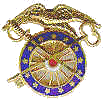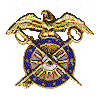
Original Design. 1896 War Department General Order #40 of 3 September 1896 authorized the sword, key, wheel and eagle as the insignia of the Quartermaster Corps. The insignia was designed by Captain Oscar F. Long at the direction of the Quartermaster General, Brigadier General Richard Batchelder. This insignia is different from the current issue in that the eagle had its head down in front of the wing just ready to take off in flight. This design is now called the “Regimental Eagle” and was incorporated in 1986 into the Quartermaster Regimental Crest and in 1994 into the Coat of Arms of the Quartermaster Regiment that are displayed on the Quartermaster Regimental flag.
Symbolism
The sword is characteristic of military forces and symbolized the Quartermaster Corps control of military supplies. The key is representative of the Corps traditional storekeeping function. The wheel is styled after a six-mule-wagon wheel and represents transportation and delivery of supplies. The wheel has thirteen spokes, a red and white hub and a blue felloe (the outer edge of the wheel) embedded with thirteen gilt (gold) stars. The thirteen stars and spokes of the wheel represent the original colonies and the origin of the Corps which occurred during the Revolutionary War. The gilt (gold) eagle is the national bird and is symbolic of our nation. The colors red, white and blue are the national colors.
Current Design

In September 1921 a modified Quartermaster branch insignia was approved. It was redesigned with the eagle’s head shown erect which is called the “upright displayed eagle”. This change was in response to a 1918 letter by the Secretary of War which directed the review of all Army insignia by the National Commission of Fine Arts. The eagle was redesigned by Charles Livingston Bull of the Commission, one of the foremost animal painters in the country. Flora F. Sherwood of the Office of the Quartermaster General drew the new insignia. The new design did not see widespread use until the mid 1930s. This is probably due to the large stocks of the old insignia, tradition and the cost of acquiring the new insignia.
